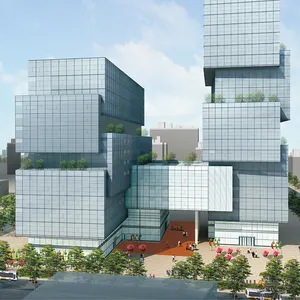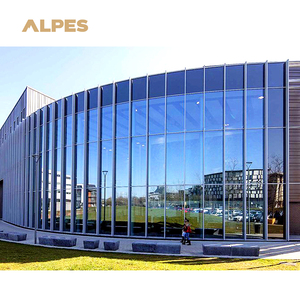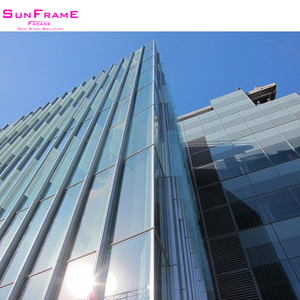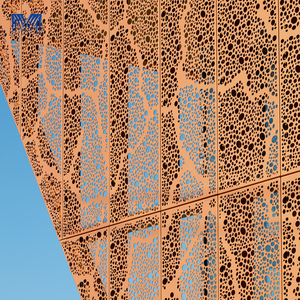(2222 products available)






































































































































































































































There are two types of unitized curtain wall systems, double-skin and single-skin. Below are descriptions of each of them.
The single-skin unitized curtain wall is an exterior wall made of metal and glass. It is attached to the building's structure. This system provides a quick and cost-effective way to enclose a building. Since it is a single layer, it is lightweight and has fewer materials. This system's straightforward design makes it easy to install and maintain.
The double-skin unitized curtain wall is a more complex exterior wall system. It has two layers of glass, creating an air space between them. This air space acts as insulation. Because of this, the double-skin system is more energy-efficient than the single-skin system. It can help keep buildings warmer in winter and cooler in summer. The two layers of glass also make this system quieter. They block out noise from the street better than the single-skin wall. Additionally, the air space between the glass reduces condensation, which prevents water from dripping and forming on the inside.
The double-skin unitized wall also has a modern and sleek look. It gives buildings a high-end appearance. But all these benefits come at a higher price. It uses more materials and is heavier than the single-skin unitized wall. The installation and maintenance are also more complicated.
Aside from these two, there are other types of unitized curtain walls. For example, a structural glazed unitized curtain wall is a glass exterior wall system that is bonded to the frame using special sealants. This creates a smooth and clean glass surface without visible aluminum mullions. Another type is the glass skylight unitized curtain wall. It is installed on the roof of a building. This type allows more light to come into the interior space and creates an open and airy feel. It uses glass panels that are framed and supported like regular unitized walls. However, it has additional features such as structural support, drainage, and weatherproofing. There is also a hybrid unitized curtain wall. This combines both the structural glazed unitized walls and the skylight walls.
When looking for features, it is important to look for the functions of a unitized curtain wall. Below are some of the functions and features of a unitized curtain wall system.
Structural Integrity
The unitized curtain wall system is designed to provide structural integrity. It is built to withstand wind loads, seismic activities, and other environmental stresses. This ensures the safety of the occupants and the building is safe.
Weather Resistance
Unitized curtain wall systems are designed to resist weather elements. They have durable materials and sealing systems that prevent water infiltration. This minimizes the risk of moisture damage.
Thermal Insulation
Thermal insulation is an important feature of a unitized curtain wall. It maintains a comfortable indoor temperature. This reduces the energy needed for heating and cooling. Thermal insulation minimizes energy costs and is environmentally friendly.
Noise Reduction
Noise reduction is a key feature of a unitized curtain wall system. It consists of tightly sealed panes of glass that minimize sound transmission. This creates a quiet and peaceful environment.
Durability
Durability is a key feature of unitized curtain walls. They are constructed with high-quality materials like aluminum. Aluminum can withstand harsh weather conditions without deteriorating. These materials resist corrosion, which ensures the unitized curtain wall maintains its appearance over time.
Aesthetic Flexibility
Unitized curtain walls offer aesthetic flexibility. This allows architects and designers to customize the appearance of the wall. It consists of different materials and finishes that can be integrated into a building's design.
Quick Installation
Unitized curtain walls are installed quickly and efficiently. This is because of the prefabricated units that are constructed off-site. The prefabricated units are assembled on-site reducing construction time and labor costs.
Enhanced Glazing Options
The unitized curtain wall system allows for enhanced glazing options. This includes triple glazing or the use of vacuum-insulated glass. These options improve thermal insulation and noise reduction.
Improved Air Quality
Unitized curtain wall systems improve air quality. This is because of the operable windows that are integrated into the system. The operable windows allow for natural ventilation and the circulation of fresh air.
The global demand for unitized curtain wall systems is on the rise. This is because it offers sustainable and energy-efficient solutions. Also, it provides innovative design options for various types of buildings. Its usage is expected to grow in the following scenarios:
Commercial Construction Projects
Unitized curtain wall systems are widely used in large-scale commercial projects. For example, high-rise office buildings, hotels, and mixed-use developments. Each system provides the fast and efficient onsite assembly. This reduces construction time and enhances the building's energy efficiency. The pre-assembled components minimize the need for extensive glazing and framing work at the site.
Iconic Skyscrapers
Architects and developers of iconic skyscrapers favor unitized curtain walls. This is because of their ability to integrate complex design elements. These include innovative solar control devices, decorative metal panels, and high-performance glazing. The unitized system allows for precise factory fabrication of these components. They ensure their seamless integration and consistent quality.
Green Buildings
Unitized curtain wall systems contribute to the sustainability of Green buildings. They incorporate advanced glazing technologies. For example, triple glazing and dynamic shading devices. These technologies reduce energy consumption by regulating solar heat gain and natural light. The airtight construction of unitized systems also minimizes heat loss and infiltration.
Building Renovations
Unitized curtain walls are used in the renovation of existing buildings. This is to improve their energy efficiency and aesthetics. The new unitized system can replace outdated curtain walls. This introduces high-performance glazing and insulation. This upgrade not only enhances the building's thermal and acoustic performance but also revitalizes its exterior appearance.
Specialized Facilities
Unitized curtain wall systems are tailored for specialized facilities. For example, hospitals, laboratories, and data centers. These systems incorporate advanced glazing technologies. For example, triple glazing and dynamic shading devices. These technologies reduce energy consumption by regulating solar heat gain and natural light. The airtight construction of unitized systems also minimizes heat loss and infiltration.
Modular Construction
The unitized curtain wall systems are integral to modular construction projects. Here, entire building modules, including walls, windows, and curtain systems, are pre-assembled in the factory. This leads to enhanced quality control and rapid onsite assembly. This approach is popular among residential developers seeking to reduce construction time and costs.
When considering the purchase of a unitized curtain wall system for sale, it is important to analyze various factors to ensure the right selection. Consider the following key elements:
Project requirements
It is important to check the specifications and requirements of the project. Determine whether a prefabricated or modular system is required. Assess the scope of the project and the available budget. Consider the required design features such as materials, energy efficiency, and structural requirements.
Materials
Unitized curtain wall systems are made of different materials. Each material has its advantages and disadvantages. Commonly, they are made of aluminum, steel, and glass. Aluminum is lightweight and requires low maintenance. Steel is more durable and provides better structural support. Glass offers natural light and aesthetic appeal. Assess the performance of the materials, such as thermal insulation, weather resistance, and durability.
Design flexibility
Consider the design flexibility of the unitized curtain wall system. Opt for a system that allows customization and implementation of various design elements. Check for the color and finish options available. Consider the shape and size of the components. Look for a system that integrates easily with other building elements such as windows, doors, and roofing systems.
Ease of installation
The unitized curtain wall system is prefabricated. This means that components are manufactured in a factory and then assembled on-site. Assess the ease of installation and potential challenges. Consider the onsite assembly requirements and the available skilled labor.
Supplier expertise
Look for suppliers with a proven record of success. Check their previous projects and client testimonials. Assess their technical support and customer service.
Compliance
Ensure that the selected unitized curtain wall system complies with international building codes and regulations. Look for certifications and test reports that verify the performance of the system.
Q: What is a unitized curtain wall system?
A: A unitized curtain wall system is a method of constructing exterior walls for buildings that involves prefabricating individual units of the wall with all their components, such as glass, frame, and insulation. These units are then assembled in the factory and transported to the construction site, where they are installed as complete units. This system is efficient and reduces onsite assembly time.
Q: What is the difference between stick and unitized curtain wall?
A: The main difference between a stick and a unitized curtain wall system is in the installation method. A stick curtain wall is assembled on-site, and the framing system is installed first, followed by infill panels. In contrast, a unitized curtain wall is installed as pre-assembled units, and each unit has a framing system and infill panels.
Q: What are the types of curtain walls?
A: There are several types of curtain walls, including:
- Structural glazing curtain walls - These have a sleek, modern appearance because the framing system is often hidden behind the exterior glass.
- Brick veneer curtain walls - These incorporate a brick veneer as the exterior skin, giving a traditional look.
- Stone veneer curtain walls - Similar to brick veneer walls, these use stone as the exterior skin.
- Unitized curtain walls - As discussed, these are prefabricated and installed as complete units.
- Stick-built curtain walls - These are constructed on-site, as described earlier.
Q: What are the disadvantages of a curtain wall?
A: Some potential disadvantages of a curtain wall include:
- Thermal Bridging: Curtain walls, particularly those with metal framing, can be prone to thermal bridging. This is where heat or cold can transfer through the wall more easily than insulation. This can reduce the wall's energy efficiency.
- Condensation: If not designed properly, curtain walls can have issues with condensation. This is where moisture builds up inside the wall and can lead to problems like mold.
- Cost: Curtain walls can be more expensive than traditional walls. This is because of the materials used and the need for specialized installation.
- Structural Dependence: Curtain walls are not load-bearing walls. This means they rely on the building's structure for support. If the structure is not sound, the curtain wall could be at risk.
- Installation Time: Depending on the type of curtain wall, installation could take longer. For example, unitized curtain walls are installed quickly, but stick walls take more time because they are assembled on-site.